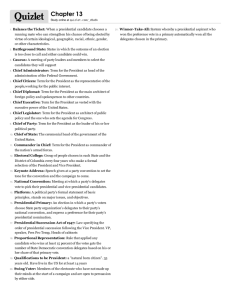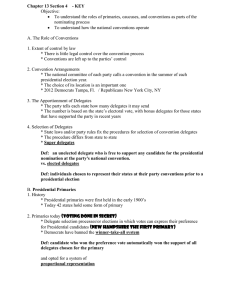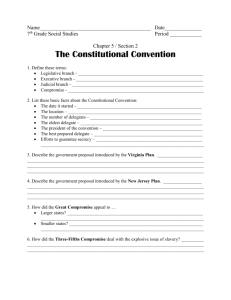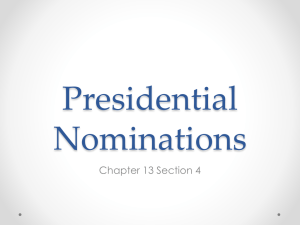The Nomination Process and Presidential Primaries
advertisement
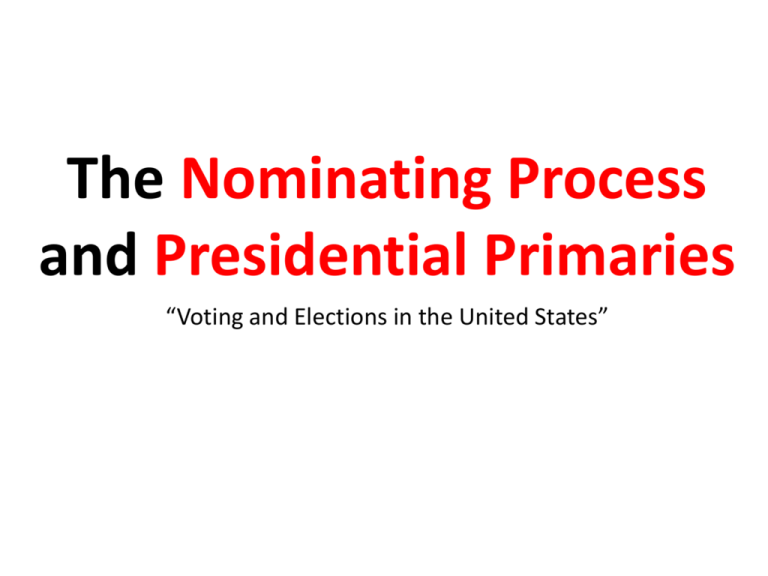
The Nominating Process and Presidential Primaries “Voting and Elections in the United States” * How does an individual get from here… … to here * * The nominating process narrows the field of possible candidates for public office! * Why is “narrowing the field” important? Example: $1,000 Step One: Self-Announcement * The potential candidate will form a Presidential Exploratory Committee to see if there is public support for running for the Presidency (MONEY is crucial to the process) * Self-announcement is the first step in the process – usually happens after the previous midterm elections are held * Mitt Romney announces 2012 presidential exploratory committee Step Two: The Primaries (and Caucuses) * Primaries are run (and paid for) by state and local governments (ARE elections) * * Caucuses are private events run by the political parties themselves (are NOT elections – more like meetings)! ** This part of the process begins in January the year of a Presidential election – candidates are fighting for DELEGATES who will go to the National Convention and vote for their candidate! ** * Democrats also use SUPER-DELEGATES who go to the National Convention unpledged and can cast their vote for whoever they please! The Caucus System * Alaska, Colorado, Hawaii, Kansas, Maine, Minnesota, Nevada, North Dakota, Wyoming and Iowa * * American Samoa, Guam and the Virgin Islands The Primary System * Primary Elections are elections held within the party to choose the candidate who will oppose the other party’s candidate * * A direct primary is an indirect election! As each state holds their primary or caucus, delegates are awarded to the competitors in relation to how they finish… Types of Primaries * Closed primaries – voters cannot vote for a candidate in the opposite party. * If you are an identified Democrat, you can only vote for a Democratic candidate. (OHIO is considered a “Semi-Closed” Primary) * Open primaries – voters can vote for a candidate in any party. * Receive two ballots, cast one – choose on your own. Now, here is where it gets confusing – BUT, we will try and keep it simple! Each state has a portion of these delegates given to them by the RNC to give to the Republican candidates * 5 “At-large” delegates for each U.S. Senator (10) * 3 “District” delegates for each U.S. Representative (16x3=48) * 3 “Party Leader” delegates (3) * 0 “Electoral College” Bonus delegates * 1 “U.S. Senator” Bonus delegate * 1 “Republican Governor” Bonus delegate * 1 “U.S. House Majority” Bonus delegate * 1 “One Chamber” Bonus delegate * 1 “All Chambers” Bonus delegate “Winner-take-all” vs. “Proportional” Delegate Distribution * Democrats use a MUCH MUCH MUCH more complicated system for distributing delegates (I’ll spare you the pain) Step Three: the National Convention * The National Convention is the final step in the nomination process * Purpose of the convention is to officially nominate a candidate for the upcoming Presidential election! * Signifies the end of primary season and the start of campaigning for the general election… * Goals for the National Conventions: 1. Nominate the President/Vice-President 2. Unite the party! 3. Create (and accept) the party platform 2012 Republican National Convention Tampa, Florida – August 27, 2012 2012 RNC Highlights 2012 Democratic National Convention Charlotte, North Carolina – September 6, 2012 2012 DNC Highlights * How does an individual get from here… … to here * * The nominating process narrows the field of possible candidates for public office! *



